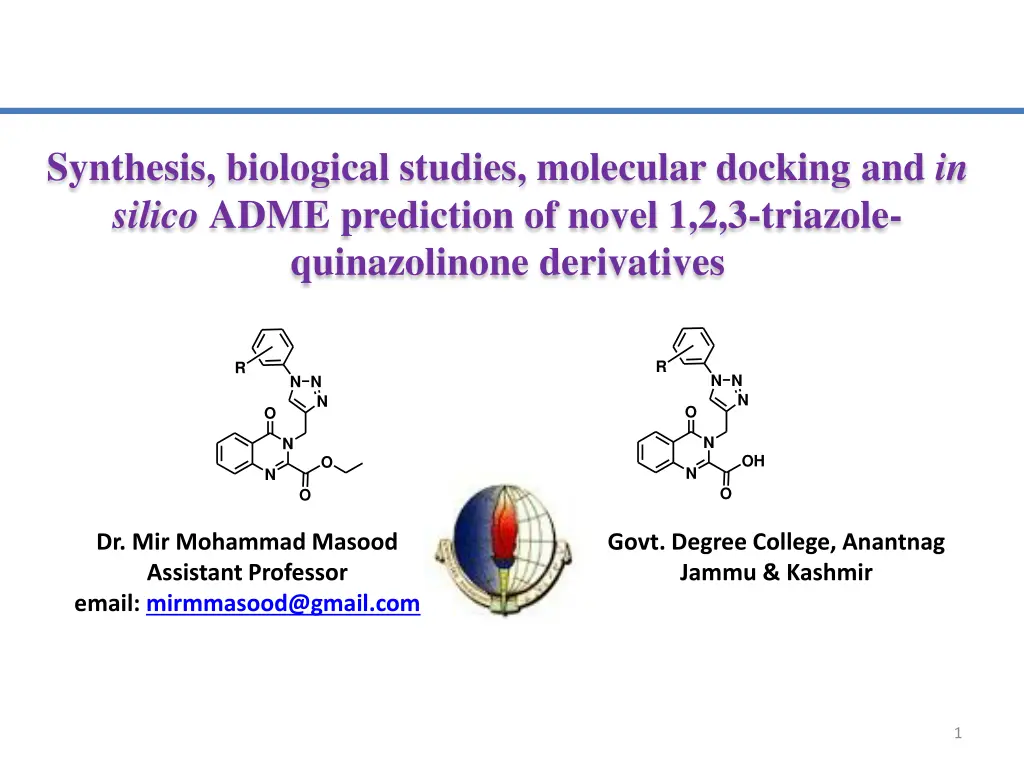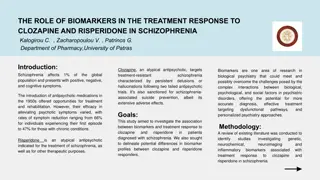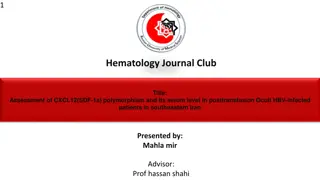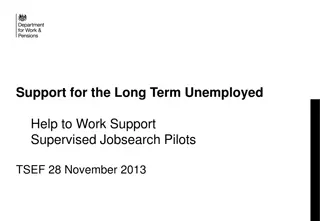
Triazole-Quinazolinone Derivatives: Synthesis and Biological Studies
Explore the synthesis, biological studies, molecular docking, and in silico ADME prediction of novel 1,2,3-triazole-quinazolinone derivatives by Dr. Mir Mohammad Masood. Learn about the design strategy based on antifungal drugs, the significance of triazoles and quinazolinones, and the medicinal chemistry history. Discover the biological importance and structures of FDA-approved triazole-bearing drugs. Dive into the world of heterocyclic compounds and their potential in pharmaceuticals.
Download Presentation

Please find below an Image/Link to download the presentation.
The content on the website is provided AS IS for your information and personal use only. It may not be sold, licensed, or shared on other websites without obtaining consent from the author. If you encounter any issues during the download, it is possible that the publisher has removed the file from their server.
You are allowed to download the files provided on this website for personal or commercial use, subject to the condition that they are used lawfully. All files are the property of their respective owners.
The content on the website is provided AS IS for your information and personal use only. It may not be sold, licensed, or shared on other websites without obtaining consent from the author.
E N D
Presentation Transcript
Synthesis, biological studies, molecular docking and in silico ADME prediction of novel 1,2,3-triazole- quinazolinone derivatives R R N N N N N N O O N N OH O N N O O Dr. Mir Mohammad Masood Assistant Professor email: mirmmasood@gmail.com Govt. Degree College, Anantnag Jammu & Kashmir 1
Designing strategy for present work based on available antifungal drugs. 2
1,2,3-triazoles Triazoles are heterocyclic compounds with three nitrogen and two carbon atoms in a five-membered ring. Two isomeric forms of triazoles with the molecular formula C2H3N3 exists viz. 1,2,3-triazole and 1,2,4- triazole. NH N NH N N N 1,2,3-triazole 1,2,4-triazole 3
> 92 C Scheme: Azide-alkyne cycloaddition reactions for the synthesis of 1,2,3-triazole. The synthesis of 1,2,3-triazole moiety is mainly based upon classical Huisgen 1,3-dipolar cycloaddition under thermal conditions. 4
Biological Importance of triazoles N N N F N N N N N O Cl N HO F N N NN O O O Cl N Itraconazole Fluconazole N N OH N N N N N N N F N OH N O O F F O N F F Posaconazole N Voriconazole O N H O O OH S N N N N O N NN NH O OH N N S O N O O HO F S HO N H Cl N Tazobactam Cefatrizine NH2 Albaconazole F Cl O O N H2N N F N H2N Cl Cl O N F N H2N N Carboxyamidotriazole Rufinamide 5 Fig: Structure of FDA-approved triazole bearing drugs.
Quinazolinones Depending upon the position of the keto group, quinazolinones may be classified into three types 2(1H)- quinazolinone, 4(3H)-quinazolinone and 2,4(1H,3H)- quinazolinedione. O O N NH NH N H O N H O N 2(1H)-quinazolinone 4(3H)-quinazolinone 2,4(1H,3H)-quinazolinedione The first quinazolinone compound was obtained as early as 1869 from anthranilic acid and cyanogens to give 2- cyanoquinazolinone. 6
Interest in the medicinal chemistry of quinazolinone derivatives was stimulated in the early 1950s with the elucidation of febrifugine, a quinazolinone alkaloid, effective against malaria. Meantime (in 1951), in a quest to find out additional potential of quinazolinone-based drugs, methaqualone was synthesized, which was famous for its sedative hypnotic effects. O O O N N H N N N Febrifugine Methaqualone HO 7
Biological Importance of Quinazolinones Fig: Some natural and synthetic bioactive compounds containing quinazolinone ring. 8
Synthesis of 1,2,3-tiazolequinazolinone conjugates. O O O NH2 a NH O O O NH2 N 1 O O b Br R H o-Cl o-F o-CH3 o-OCH3 o-NO2 m-Cl m-F m-CH3 m-OCH3 m-NO2 p-Cl p-F p-CH3 p-OCH3 p-NO2 p-COOH 3a 3b 3c 3d 3e 3f 3g 3h 3i 3j 3k 3l 3m 3n 3o 3p 3q O N O N 2 O NH2 N3 c d R R 4a-q 3a-q R R N N N N N N O O e N N O OH N N O 5a-q O 6a-q Scheme: Reagents and conditions: (a) Reflux (185 186 C), 5 h, 82%; (b) K2CO3, DMF, 0 C rt, 3 h, 92%; (c) NaNO2 in HCl, NaN3, 0 C rt, 2.5 h; (d) CuSO4.5H2O, sodium ascorbate, THF:H2O (1:2), rt, 4 5 h, 90 97%; (e) LiOH.H2O, THF:H2O (3:1), rt, 2 3 h, 55 89%. 9
Structure of 1,2,3-triazole-quinazolinone conjugates (5a-q) R N N N O N O N O S. No. Code R Mol. Formula Yield 1 5a H C20H17N5O3 92% 2 5b o-Cl C20H16ClN5O3 89% 3 5c o-F C20H16FN5O3 93% 4 5d o-CH3 C21H19N5O3 88% 5 5e o-OCH3 C21H19N5O4 89% 6 5f o-NO2 C20H16N6O5 91% 7 5g m-Cl C20H16ClN5O3 96% 10
Cont Cont S. No Code R Mol. Formula Yield 8 5h m-F C20H16FN5O3 97% 9 5i m-CH3 C21H19N5O3 93% 10 5j m-OCH3 C21H19N5O4 94% 11 5k m-NO2 C20H16N6O5 95% 12 5l p-Cl C20H16ClN5O3 94% 13 5m p-F C20H16FN5O3 97% 14 5n p-CH3 C21H19N5O3 89% 15 5o p-OCH3 C21H19N5O4 87% 16 5p p-NO2 C20H16N6O5 93% 17 5q p-COOH C21H17N5O5 91% 11
Structure of 1,2,3-triazole-quinazolinone conjugates (6a-q) R N N N O N OH N O S. No. Code R Mol. Formula Yield 1 6a H C18H13N5O3 89% 2 6b o-Cl C18H12ClN5O3 81% 3 6c o-F C18H12FN5O3 55% 4 6d o-CH3 C19H15N5O3 56% 5 6e o-OCH3 C19H15N5O4 59% 6 6f o-NO2 C18H12N6O5 87% 7 6g m-Cl C18H12ClN5O3 78% 12
Cont Cont S. No Code R Mol. Formula Yield 8 6h m-F C18H12FN5O3 56% 9 6i m-CH3 C19H15N5O3 83% 10 6j m-OCH3 C19H15N5O4 76% 11 6k m-NO2 C18H12N6O5 81% 12 6l p-Cl C18H12ClN5O3 81% 13 6m p-F C18H12FN5O3 72% 14 6n p-CH3 C19H15N5O3 71% 15 6o p-OCH3 C19H15N5O4 85% 16 6p p-NO2 C18H12N6O5 64% 17 6q p-COOH C19H13N5O5 65% 13
Characterization of synthesized compounds = 2.392 (s,3H, CH3) = 5.662 (s,2H, CH2) = 8.059 (s,1H, CH) 1H NMR spectrum of representative compound 5n 14
Cont Cont 13C NMR spectrum of representative compound 5n 15
Cont Cont = 5.404 (s,2H, CH2) = 8.611 (s,1H, CH) 1H NMR spectrum of representative compound 6k 16
Cont Cont 13C NMR spectrum of representative compound 6k 17
Cont Cont LC-MS spectrum of representative compound 6k 18
X-ray crystallographic analysis of 2 and 5c N N F O N O N N O N O N O O 2 5c Fig: Singlecrystal X-ray structure of compound 2 & 5c. 19
Anticandidal evaluation Table: In vitro anticandidal activity of compounds (5a q) against Candida spp. Compound Code IC50 (mean SD)a g/mL Candida glabrata Candida albicans Candida tropicalis R 5a 74.66 2.13 227.71 3.84 181.83 7.55 H 5b 65.63 4.32 o-Cl 124.39 18.43 183.45 12.33 5c 87.12 2.22 o-F 109.88 4.76 244.66 17.47 5d o-CH3 297.22 5.94 351.31 6.32 190.98 17.23 5e 18.61 3.42 13.47 2.49 o-OCH3 181.80 9.75 5f o-NO2 269.41 5.50 272.36 4.41 238.55 7.12 5g 65.58 3.20 58.17 2.44 28.17 2.44 m-Cl 5h m-F 509.49 6.41 364.85 3.40 182.14 11.57 20
Cont Cont Compound Code IC50 (mean SD)a g/mL Candida glabrata Candida albicans Candida tropicalis R 5i 352.60 11.05 395.10 7.46 137.11 6.49 m-CH3 5j 340.48 7.36 416.98 2.27 113.20 3.67 m-OCH3 5k m-NO2 142.61 2.55 354.04 5.43 117.02 3.22 5l p-Cl 215.55 3.47 194.87 3.42 249.73 9.68 5m p-F 209.26 6.49 292.53 9.11 434.85 15.46 5n 14.62 2.14 8.36 1.31 12.37 3.21 p-CH3 5o p-OCH3 394.29 1.67 118.25 6.52 441.67 4.28 5p p-NO2 151.20 15.68 315.51 8.93 213.77 12.14 5q p-COOH 342.30 5.74 87.72 5.57 290.24 6.74 FLC 15.6 2.23 7.8 1.52 8.5 1.71 21
Cont Cont Table: In vitro anticandidal activity of compounds (6a q) against Candida spp. Compound Code R IC50 (mean SD)a g/mL Candida glabrata Candida albicans Candida tropicalis 6a H 118.74 7.61 566.07 9.43 184.13 4.82 6b o-Cl 168.76 3.38 266.46 10.29 210.63 13.31 6c 24.78 2.67 o-F 100.72 3.67 174.36 3.12 6d o-CH3 131.17 4.32 357.67 6.82 233.06 6.88 6e 48.17 3.17 29.38 4.18 9.09 2.69 o-OCH3 6f o-NO2 700.85 23.60 486.65 18.48 520.72 24.12 6g m-Cl 100.35 4.02 278.14 3.99 244.65 2.05 6h m-F 134.80 2.37 261.89 13.29 175.21 3.6322
Cont Cont Compound Code R IC50 (mean SD)a g/mL Candida glabrata Candida albicans Candida tropicalis 6i m-CH3 133.44 4.25 244.77 11.23 222.80 18.69 6j m-OCH3 214.35 11.02 453.30 13.17 444.08 17.37 6k m-NO2 700.85 23.60 486.65 18.48 520.72 24.12 6l p-Cl 220.89 11.21 517.05 18.63 303.32 8.50 6m p-F 171.92 5.29 421.65 15.36 231.21 5.71 6n 86.96 4.05 13.54 2.98 p-CH3 288.33 7.37 6o p-OCH3 124.87 5.93 718.37 13.18 162.33 5.24 6p p-NO2 789.23 16.40 432.53 10.31 336.61 11.07 6q p-COOH 916.32 15.47 522.05 4.02 457.29 10.70 FLC 15.6 2.23 7.8 1.52 8.5 1.71 23
Hemolytic assay 90 80 70 % Hemolysis 60 5e 5g 5n 6c 6e 6n FLC 50 40 30 20 10 0 25 50 100 200 400 600 800 1000 Concentration in g/mL Fig: Hemolytic activity of compounds 5e, 5g, 5n, 6c, 6e and 6n on human RBCs. 24
Cytotoxic Activity by MTT assay 100 90 80 % Cell Viability 70 5e 60 5g 50 5n 40 6c 30 6e 20 6n 10 0 0 20 40 60 80 100 120 140 160 180 200 220 Concentration g/mL Figure: Cell viability assay on HEK-293 cell line. 25
Molecular Docking studies of compounds 5n Fig. Docking of 5n with lanosterol 14 -demethylase of pathogen C. albicans (PDB: 5v5z): (a) compound 5n (yellow) showing interaction with Heme porphyrin ring (violet) which involves in oxidation process; (b) overlapping image of original inhibitor of protein 1YN (green) and compound 5n within the same binding pocket. 26
ADME properties Table: In silico ADME prediction data of the title compounds 5a q QP log P o/wd QP logSe QP log Khsaf QP log BBg Compd MWa SASA PSA NRB HBDbHBAc VLR5 %HOAh 5a 375.38 679.855 93.977 4.00 0.00 8.00 2.790 -4.260 -0.293 -0.783 0 100 5b 409.83 695.861 91.430 4.00 0.00 8.00 3.259 -4.814 -0.192 -0.554 0 100 5c 393.37 685.159 92.972 4.00 0.00 8.00 2.996 -4.514 -0.259 -0.658 0 100 5d 389.41 700.262 90.193 4.00 0.00 8.00 3.131 -4.647 -0.158 -0.660 0 100 5e 405.41 712.625 100.044 5.00 0.00 8.75 2.839 -4.326 -0.337 -0.820 0 100 5f 420.38 708.418 130.747 5.00 0.00 9.00 2.193 -4.115 -0.423 -1.589 1 69 5g 409.83 703.976 93.977 4.00 0.00 8.00 3.296 -5.030 -0.164 -0.630 0 100 5h 393.37 688.530 93.977 4.00 0.00 8.00 3.024 -4.627 -0.248 -0.678 0 100 5i 389.41 712.243 93.977 4.00 0.00 8.00 3.118 -4.874 -0.117 -0.812 0 100 5j 405.41 706.853 102.995 5.00 0.00 8.75 2.761 -4.217 -0.355 -0.853 0 100 5k 420.38 721.890 141.554 5.00 0.00 9.00 2.032 -4.371 -0.375 -2.015 1 62 27
Cont Cont QP log P o/wd QP logSe QP log Khsaf QP log BBg Compd MWa SASA PSA NRB HBDbHBAc VLR5 %HOAh 5l 409.83 703.954 93.977 4.00 0.00 8.00 3.296 -5.029 -0.164 -0.630 0 100 5m 393.37 688.516 93.977 4.00 0.00 8.00 3.024 -4.627 -0.248 -0.678 0 100 5n 389.41 712.059 93.977 4.00 0.00 8.00 3.116 -4.871 -0.118 -0.812 0 95 5o 405.41 715.461 102.059 5.00 0.00 8.75 2.837 -4.380 -0.322 -0.867 0 100 5p 420.38 724.784 148.449 5.00 0.00 9.00 1.910 -4.425 -0.332 -2.330 1 57 5q 419.39 726.372 146.595 5.00 1.00 10.00 2.374 -4.907 -0.361 -2.116 0 65 aMolecular weight(130.0/725.0), bNo. of H-bond donor groups (0/6), cNo. of H- bond acceptor groups (2/20), doctanol/water partition coefficient (-2.0/6.5), epredicted aqueous solubility (-6.5/0.5), fprediction of binding to human serum albumin (-1.5/1.5),gpredicted brain/blood partition coefficient (-3.0/1.2), h% Human Oral Absorption in GI (<25% is poor); The values in bracket signify Range for 95% of drugs. 28
Cont Cont Table: In silico ADME prediction data of the title compounds 6a 6q QP log P o/wd QP logSe QP log Khsaf QP log BBg Compd MWa SASA PSA NRB HBDbHBAc VLR5 %HOAh 6a 347.33 601.932 115.398 3.00 1.00 8.00 2.312 -3.874 -0.382 -1.279 0 72 6b 381.77 590.898 108.709 3.00 1.00 8.00 2.570 -3.939 -0.383 -0.944 0 76 6c 365.32 580.209 110.252 3.00 1.00 8.00 2.318 -3.665 -0.439 -1.037 0 80 6d 361.36 594.823 107.471 3.00 1.00 8.00 2.437 -3.755 -0.353 -1.052 0 76 6e 377.35 607.644 117.323 4.00 1.00 8.75 2.188 -3.537 -0.491 -1.212 0 73 6f 392.33 603.449 148.018 4.00 1.00 9.00 1.565 -3.378 -0.554 -1.882 1 45 6g 381.77 599.023 111.256 3.00 1.00 8.00 2.599 -4.137 -0.363 -1.017 0 75 6h 365.32 583.578 111.256 3.00 1.00 8.00 2.343 -3.770 -0.431 -1.055 0 74 6i 361.36 607.289 111.256 3.00 1.00 8.00 2.413 -3.963 -0.324 -1.204 0 74 6j 377.35 603.714 120.269 4.00 1.00 8.75 2.153 -3.472 -0.489 -1.228 0 73 6k 392.33 616.936 158.832 4.00 1.00 9.00 1.390 -3.601 -0.520 -2.278 1 38 29
Cont Cont QP log P o/wd QP logSe QP log Khsaf QP log BBg Compd MWa SASA PSA NRB HBDbHBAc VLR5 %HOAh 6l 381.77 599.141 111.256 3.00 1.00 8.00 2.600 -4.140 -0.363 -1.017 0 75 6m 365.32 583.575 111.256 3.00 1.00 8.00 2.342 -3.770 -0.431 -1.055 0 74 6n 361.35 607.274 111.256 3.00 1.00 8.00 2.413 -3.963 -0.324 -1.204 0 74 6o 377.35 611.874 118.940 4.00 1.00 8.75 2.200 -3.607 -0.472 -1.257 0 73 6p 392.33 618.820 159.698 4.00 1.00 9.00 1.393 -3.632 -0.513 -2.305 1 37 6q 391.34 619.932 161.935 4.00 2.00 10.00 1.497 -3.555 -0.756 -2.324 0 40 aMolecular weight(130.0/725.0), bNo. of H-bond donor groups (0/6), cNo. of H- bond acceptor groups (2/20), doctanol/water partition coefficient (-2.0/6.5), epredicted aqueous solubility (-6.5/0.5), fprediction of binding to human serum albumin (-1.5/1.5),gpredicted brain/blood partition coefficient (-3.0/1.2), h% Human Oral Absorption in GI (<25% is poor); The values in bracket signify Range for 95% of drugs. 30
Conclusion A novel series of 1,2,3-triazole quinazolinone conjugates (5a 5q) and (6a 6q) were prepared and evaluated for anticandidal activity. All the synthesised compounds were characterized by IR, 1H, 13C NMR, mass spectroscopic techniques and elemental analysis. The in vitro anticandidal results show that all the synthesized compounds possess anticandidal activity to certain extent. The compounds 5g, 5n and 6e show good activity against all the three strains of Candida, viz. C. albicans,C. glabrata and C. tropicalis. The compound 5n emerged as a most potent inhibitor among compounds (5a 5q) and 6e among compounds (6a 6q). Docking studies of compound 5n showed good binding affinity with CYP51 enzyme of C. albicans (PDB: 5v5z). The hemolysis and cytotoxicity results of compounds 5e, 5g, 5n, 6c, 6e and 6n revealed non-toxic nature of these compounds. In silico ADME prediction of synthesized compounds indicated that compounds have a potential to develop as good oral drug candidate. 31
Thank You 32










